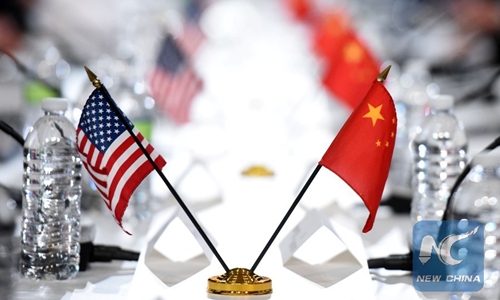HOME >> OPINION
China-US trade mechanism key to progress
By Ling Shengli Source:Global Times Published: 2020/1/22 20:14:28

File photo taken on November 23, 2016 shows the national flags of the United States and China during the 27th Session of the China-US Joint Commission on Commerce and Trade in Washington DC, US. Photo: Yin Bogu/Xinhua
After protracted trade negotiations, China and the US finally signed the phase one trade deal on January 15. This agreement did not come easily. Both sides went through a 22-month trade battle and 13 rounds of high-level consultations. Although the phase one deal was reached, trade conflicts between the two sides remain unresolved. It is necessary to establish a mechanism for future trade and economy negotiations between China and the US.
Right before signing the deal, the Wall Street Journal claimed that Beijing and Washington have agreed on new semiannual bilateral dialogues, which are intended to "pursue reforms" and "address disputes" in economy and trade. But, this information was neither confirmed nor mentioned in the phase one deal. However, as economic interactions increase and strategic competition intensifies, institutionalizing bilateral negotiations in economy and trade would be a necessity for both countries.
From bilateral trade ties to the global industrial chain, the relationship between China and the US is so close that they are now fully aware completely separating the two countries is unrealistic.
In the meantime, the trade frictions are becoming more obvious. US President Donald Trump constantly finds fault with China in terms of economy, which led to the China-US trade war that has lasted for nearly two years. In order to deal with the differences, leaders, senior officials and negotiating teams from the two countries made plenty of phone calls and flew back and forth across the Pacific. However, even with all these efforts, the negotiations did not go very well. The lack of an institutionalized trade consultation mechanism is likely one of the reasons.
For a troubled relationship like that between China and the US, it is hard to maintain strategic stability without a series of communication mechanisms. As a matter of fact, over 100 dialogue mechanisms have been established between the two countries. For example, in the field of economy and trade, there are several, such as the China-US Strategic and Economic Dialogue (S&ED) and China-US Comprehensive Economic Dialogue (CED). However, not all are effective. After the first round of the CED in July 2017, the dialogue has not been held as scheduled due to the trade war, rendering the CED ineffective. Looking back at the obstacles and hardships the two countries have been through, establishing a regular consultation mechanism is of great importance.
Since the trade issues between China and the US cover many areas and government departments, an institutionalized mechanism will be conducive to reducing the costs. Take the phase one deal as an example. The negotiations covered intellectual property rights, technology transfer, trade in food and agricultural products, expanding trade, bilateral evaluation and dispute resolution. This involves departments related to diplomacy, commerce, finance and agriculture. The time savings stemming from having a trade consultation mechanism with relatively fixed members would be immense.
The new China-US trade consultation mechanism can be formed based on previous history and experience. As trade ties get tighter, strengthening the trade consultation body will be an inevitable outcome, which can also be seen as a product of the complexity of two countries' strategic competition. From the S&ED to the CED, China-US trade negotiations have a long history with much experience to learn from. The biggest difficulty will be how to maintain the running of the trade mechanism if other areas of cooperation were to decline.
While a new mechanism will surely benefit China and the US, it will also have a positive knock-on effect on global trade order and economic governance. China-US relations are one of the most important economic bilateral relations in the world. The development of China-US trade ties is highly connected with global trade order and economic governance. At present, if trade frictions between China and the US cannot be dealt with properly, institutional mechanisms for international trade, such as the WTO, will be affected. An effective China-US trade consultation mechanism will be of significance to the global economy.
Undoubtedly, forming a stable trade consultation mechanism is not going to be easy. Not only will the US shift its approach to China as new administrations are sworn in, personnel adjustments and competition over interests among government departments will negatively impact the consistency of the trade consultation mechanism. Additionally, the mechanism could be impacted by the condition of other fields where China and the US have cooperation. But all in all, China-US relations and their trade ties have entered a crucial point where a trade consultation mechanism will be of great importance in reinforcing communication and understanding.
The author is secretary-general of the International Security Study Center at China Foreign Affairs University. opinion@globaltimes.com.cn
Posted in: VIEWPOINT